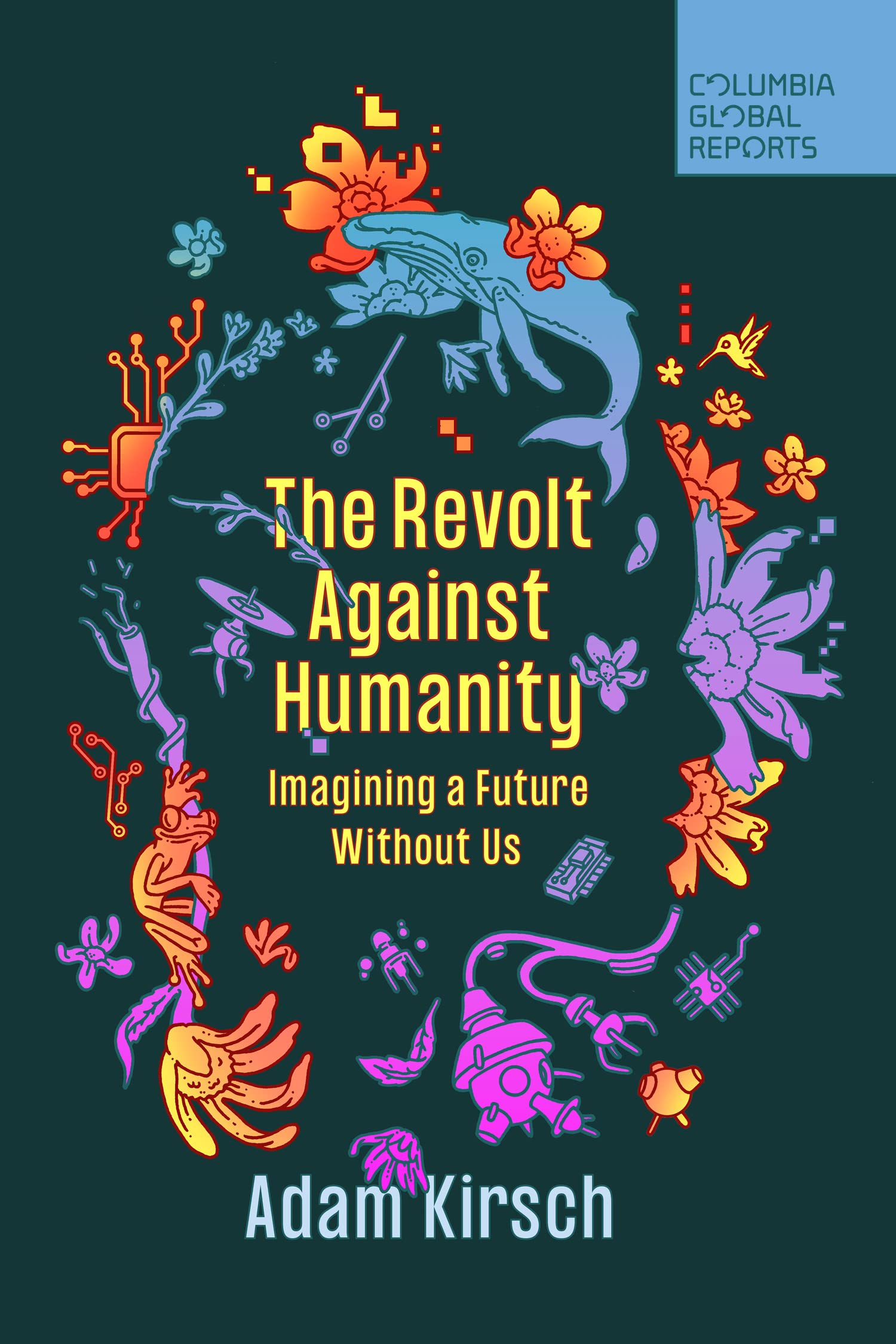The figures discussed by Kirsch fall into two groups that both “welcome” the fast-approaching “end of humanity’s reign on earth.” First are the “Anthropocene antihumanists.” Like environmental activists who predict “doomsday”—and for the same reasons—they anticipate the extinction of humanity, or, at any rate, of civilization as we know it. Unlike those activists, however, they celebrate, rather than bemoan or resist, our forthcoming demise. Nature, which we are in the business of destroying—along with ourselves—will be much better off without us. Second are the “transhumanists,” for whom humanity will not be entirely erased but transformed into “new forms of intelligent life that will no longer be Homo sapiens,” such as computers equipped with artificial general intelligence.
Antihumanists and transhumanists sound very different from one another, with the latter, notably, glorifying the scientific and technological juggernaut that the former hold responsible for the devastation of the earth. So has Kirsch, by covering them both, in effect written two books for the price of one? No, for while their “two ways of thinking […] appear to be opposites,” their affinities are close. Together, they comprise a revolt against humanity that is a “spiritual development of the first order,” in the same category as Christianity and communism—“a new way of making sense of the nature and purpose of human existence.”
The revolt against humanity, Kirsch argues, is no longer an “avant-garde phenomenon” of interest only to the chattering classes, and the spiritual development it represents is bound to impact our understanding of humanity’s place in the world. Antihumanists and transhumanists agree that human beings are not the sole source—or possessors—of meaning and value. For figures like the poet Robinson Jeffers and the philosopher Timothy Morton, nature itself is replete with significance, while prophets of a “posthuman” world, like Nick Bostrom, envisage creatures whose heightened musical sensibility will make Mozart sound to them like Muzak does to us. Again, the revolt is likely to “radicalize” what Foucault called “biopolitics.” As the antihumanist accusation of a moral crime against future generations and against nature gets louder, current commitments to increasing both population and wealth are liable to be abandoned—a prospect that many transhumanists will welcome, given their predilection for a small population of scientifically educated people focused more on working towards a high-tech utopia than on the comforts of life.
While Kirsch mentions some salient differences between the antihumanist and transhumanist visions, he arguably exaggerates their affinity. At any rate, there are significant contrasts that he doesn’t identify. For example, he rightly points out that Anthropocene antihumanists endorse misanthropy in the philosophers’ sense of a very negative assessment of humanity’s moral condition. This negative assessment, however, is not one that transhumanists necessarily make. Indeed, if humanity is as awful—as greedy, selfish, myopic, and hubristic—as antihumanists claim, it is hard to see how it could prepare for and fashion a “posthuman” future that we could look forward to without trepidation. The transhumanists’ judgment on humanity echoes Kant’s verdict on pre-Enlightenment peoples as being not evil, but “immature”—subject to irrational superstitions, traditions, and conventions. Where Kant was wrong, they will add, was to suppose that Enlightenment made human beings grow up. Human maturity may one day be reached but, ironically, only by creatures that have gone “beyond the human.”
While Kirsch’s book is always lucid, it is also nuanced in a way that makes it difficult to summarize briefly the author’s attitude to the revolt against humanity. He is, for a start, guarded in his assessment of the likelihood of the scenarios envisaged by antihumanists and transhumanists. Transhumanists, for example, have “an innate tendency to overpromise,” but at the same time are—like some antihumanists too—genuinely “extrapolating from developments that are undeniably real.” But measuring the probabilities of the scenarios is anyway not Kirsch’s real concern. This is why, perhaps, he largely ignores various differences in the scenarios on offer, such as the total extinction of humanity versus “the end of industrial civilization,” or a future world of cyborgs versus one of disembodied artificial intelligences.
Kirsch’s primary concern is with the revolt against humanity as a “spiritual development,” a revolt that is “highly significant even if [the revolutionaries’ predictions] don’t come to pass.” For Nietzsche, the “abysmal thought” of “the eternal return of the same” was important less as a scientific hypothesis than as a test of people’s positive or negative attitude toward life. Similarly, for Kirsch, the equally abysmal—that is, profound—thought of humanity’s imminent demise is a spur to reflection on human life, its value, meaning, and relation to nature.
Kirsch clearly welcomes the reflections and discussions that the revolt against humanity encourages or even compels. This comes out especially in his impatience with “conservative” thinkers like Leon Kass, who, without offering reasons, appeals to “the wisdom of repugnance”—the “yuck factor”—in order to stop the development of antihumanist and transhumanist ambitions in its tracks. Appeals like this, Kirsch points out, were once made in order to proscribe homosexuality and racial mixing. Feelings of “yuk” are no substitute for “rational scrutiny.”
Kirsch is critical, too, of other opponents of the revolt. In a sharp observation, he notes that traditional liberal humanists are “in a bind when it comes to the revolt against humanity.” Since societies of the kind they have created are the target of the revolt, they are tempted to suppress it. On the other hand, transhumanists, at least, purport to be driven by the very values honored by humanists—“freedom, reason, moral autonomy.” A comparable “trap” is one that orthodox subscribers to “human-centered environmentalism,” such as E. O. Wilson or Naomi Klein, find themselves in. For they are forced to advocate dramatic technological, economic, or social interventions that “keep pushing [us] further into the Anthropocene,” albeit in the hope of reclaiming “a green world.”
Antihumanists and transhumanists also come in for criticism beyond that of the wildness of some of their predictions. Kirsch judges as “outrageous,” for example, the celebratory tone of Patricia MacCormack and others who savor the coming “die-off” of humanity. His preference is for the sober logic of the philosopher of “antinatalism,” David Benatar. Kirsch could, though, have raised some further concerns about the “spiritual development” that he discerns in the revolt against humanity. For instance, he is too quick to accept the identification, by many prophets of the “posthuman,” of minds with information processing systems. This equation ignores the fact that we are so thoroughly “in-the-world” that our thoughts, moods, and feelings are unimaginable except through practical, embodied engagement with this world. Ignoring this, of course, makes it easier than it should be to attribute the mind to disembodied information processing.
Kirsch also misses a trick, in my judgment, in not recognizing that Anthropocene antihumanists may be as guilty of hubris as those “shallow ecologists” for whom the despoliation of nature is terrible because of the threat it poses for human well-being. When the founder of a Daoist church in the United States was asked about the “eco-crisis,” he replied: “I do not see a crisis.” His point was that it is only from a human-centered perspective that it is legitimate to speak of the “despoliation of nature,” or—to borrow the titles of two well-known books—of bringing about “the end of nature” or a world “after nature.” From a disinterested perspective—in which, say, roaches and rocks matter no more or less than people, pandas, and plants—the changes occurring in the Anthropocene are simply the latest episode in the history of the planet, and no less subject to the laws of nature than any previous ones.
The Daoist master’s attitude to the alleged eco-crisis will, of course, be much too resigned and detached for many people, including Adam Kirsch. That said, I detect a quietist tone to the book. Certainly, there is no call to arms—no injunction to bring on the disappearance of humanity or the arrival of a brave new “posthuman” era. Kirsch quotes with approval the one-time—but now “recovering”—“mainstream environmentalist” Paul Kingsnorth’s remark that “action is not always more effective than inaction.” I suspect that Kirsch shares the same writer’s “longing,” not for “progress,” but for a gentle and personal retreat or “escape” from the ugly world humanity has manufactured.
¤


